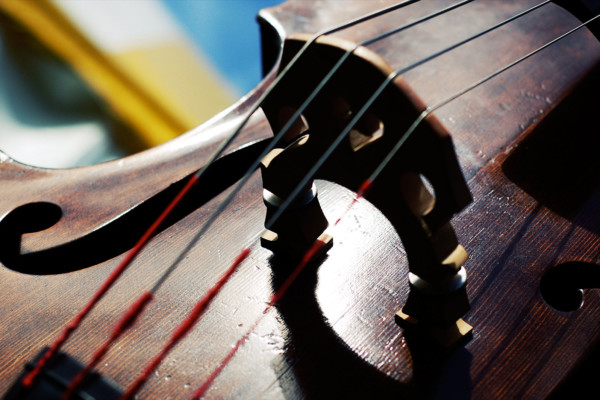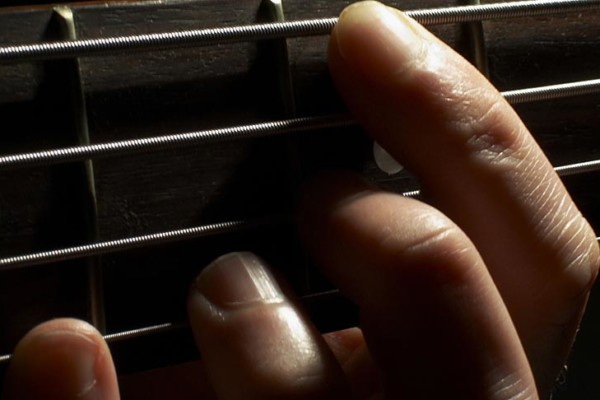Bass Chords: Going Beyond the Root
Q: Lately I’ve been trying to expand my knowledge of basic chords on bass. Any advice!
A: This seems a good time to expand on a previous column about developing chords on the bass. Previously, we had really just focused on root position chord shapes. Now let’s look at some ways to get beyond that.
Really, the key is being knowledgeable with regard to what notes are really available to you over any given chord on a chart. If you took every chord on a chart and built a chord scale out of it, you could take any combination of notes inherent to that chord and combine them to make a chord. Some will sound good, some will not. There are a few tricks I’ve developed and a few ways to experiment with this idea that might lead to some chord voicings that you like.
I recommend that you get fairly comfortable with the stuff from my last column before diving too deep into this, though. It may serve to confuse you if you’re not somewhat together with your basic chord shapes, harmony, etc.
I think a good place to start is with first inversion chords (putting the 3rd of the chord in the bass). Bass chords can be tricky because of the low register of the instrument. Some chords that sound great high up on a guitar or piano just don’t translate when played on a bass. Because of this, we have to discover what works for our instrument in particular.
The 3rd is a wonderfully consonant sound. If we begin to utilize the non chord tones as well (2, 4, 6 of the scale) then we can really come up with some hip stuff.
First, the basics:
Try playing a set of changes but with each chord in 1st inversion!
ie: For a CMaj7 chord. You’d build it from the 3rd
E G B C (this is the arpeggio in first inversion).
You can take any of those notes and put them above the E and make a cool chord out of it.
E C G sounds really nice.
I’ve devised a little trick that I utilize when playing a chord from the 3rd. This really works best with Maj 7 chord shapes:
If the chord you’re going to invert has a Maj 3rd in it, play a min7 chord from the 3rd, and vice versa!
The only exception is with diminished or half-dim chords. In this case, you have to play a -Maj7 (minor chord with a Major 7). also notated: -?7
For example:
- for a CMaj7 chord – you’d play an Emin7 = E D G
- for a Cmin7 chord – you’d play an EbMaj7 = Eb D G
- for a C-7b5 chord – you’d play an Ebmin(Maj7) = Eb D Gb
This is a quick and easy way to hip up a standard 1st inversion chord because it leads you to choose a D instead of the stock C as your note choice (the 9 of the chord). This also means that we are playing a new chord that does not include the root of the original chord. Very cool!
Now you can also play around playing the rootless version of the chord or the root inclusive version of the chord and get two different but both very nice sounds. So, now you have three choices for every chord you see!
CMaj7 can lead to:
- Root position = C E B
- 1st inversion = E G C
- alt 1st inv. = E G D
Those notes can also be voiced in any order.
So from one little experiment, we’ve added to our chord vocabulary.
Practice these over standards in the real book and you’ll get them under your fingers in no time! Remember that the key to really using this stuff is to get comfortable enough with it that you don’t have to think about it and can just jump to the 3rd and play alternate voicings over any change in real time. This means practice it a lot!
Here’s another exercise:
(Play these in the upper register of the instrument!)
- Start over a set of changes with ANY chord shape of your choosing.
- Now, for each chord change that comes, only move the notes that you HAVE to move in order to play an appropriate note for that chord.
This is a voice leading exercise that really opens up your mind to what’s really available to you! The goal is to move each note either:
- Not at all
- Half step
- At the most, a whole step.
Example:
E7 | A-7 | D7 | GMaj7 |
Let’s start with a basic voicing for our E7 chord over a 4 string spacing:
DG#-E
Now, let’s move through the changes (moving each note as little as possible, if at all!)
E7 | A-7 | D7 | GMaj7_________________________________G# | G | F# | F# D | C | C | B - | - | - | - E | E | E | D
Now, there are definitely some spots where we have to decide whether to move up or down and, through experimentation, this is where you are bound to come up with some stuff you dig (or not). Play around with it through lots of different types of chord changes and you’ll really start to get a feel for how much each chord really has in common with the next.
I also made the decision to allow myself non-chord tones (the 9 or D I used in some of the voicings). I love the 9, so I use it a lot. Experiment with all scale tones when playing over vamps, and so on.
Try and record a bass line of just whole notes of the root motion. Then play these alternate voicings over them and you’ll really hear how interesting this can be when used in context.
Have fun!
Have a question for Damian Erskine? Send it to [email protected]. Check out Damian’s instructional books, Right Hand Drive and The Improviser’s Path.



